| ¡@J-PARC News - February 2013 (Issue #95) |
| At the Materials and Life Science Experimental Facility (MLF) , high-energy high-intensity proton beams accelerated to near the speed of light are collided with a mercury target, and researchers use the high-intensity pulsed neutrons produced from the nuclear spallation reaction in which the atomic nuclei of mercury are fragmented. When the proton beams are injected, a powerful pressure wave is produced due to the heat expansion of mercury, and the resulting impact force is large enough to damage the hard metal surface of the target container (in technical jargon, this damage is called "pitting") . In the future, the MLF aims to achieve operation with a proton beam power of 1 MW, and one major issue is how to lessen this impact force. In previous off-line studies, it has been shown that the force can be weakened by mixing helium-gas microbubbles into the target mercury, and achieving a cushioning effect. Since autumn of last year, the MLF has examined performance of the actual system with built-in bubbler for producing microbubbles in the mercury target, and become the first neutron source facility in the world to demonstrate that impact force can be reduced to a fraction of its previous level. (The news was released to the press on January 30.)
Also see Issue #92 of J-PARC News (530 kW trial operation at J-PARC/MLF) . |
 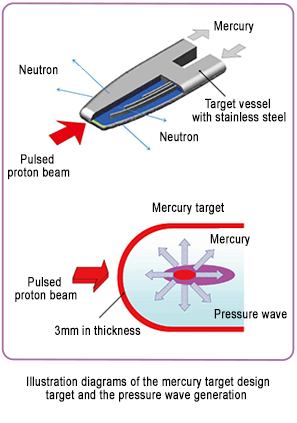  |
 * Click here to enlarge. * Click here to enlarge. * Click here to enlarge. * Click here to enlarge. |
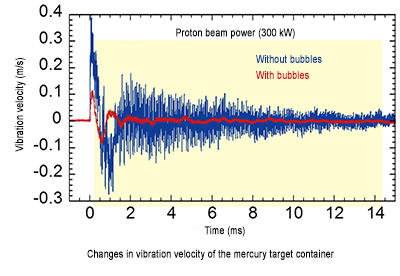 |
 * Click here to enlarge. * Click here to enlarge. |
|
| Development of KALLIOPE Positron and Electron Detector |
| In the experimental equipment for the D1 beam line installed in the muon experimental area of the MLF, research on properties and materials is being conducted through experiments using muon spin rotation method. Recently a newly developed positron and electron detector KALLIOPE (KEK Advanced Linear and Logic board Integrated Optical detector for Positron and Electron), has been installed on the line. The newly developed detector, , is almost unaffected by magnetic fields, in comparison with previous photomultiplier tubes (PMT), and uses extremely small optical semiconductors (pixel-avalanche photodiodes: p-APD) with a size approximately 10,000 times smaller. As a result, it is possible to place detectors near the sample to efficiently capture positrons and electrons, and to increase the number of channels from the previous 256 to 384 and also the number of detectors. The convenience and performance of experiments have been dramatically improved though new approaches such as introducing compact integrated circuits and new program software for converting a electrical signals (analog) from p-APDs to digital signals, and shortening adjustment time of electronic circuits and time for transferring processing data to computers by using an international standard interface.
For details, please see the KEK home page. (http://www.kek.jp/ja/NewsRoom/Highlights/20130124170000/) |
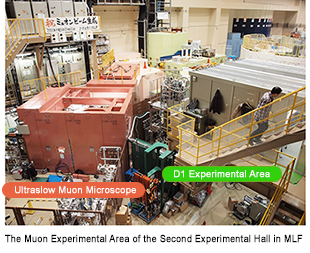 |
 * Click here to enlarge. * Click here to enlarge. |
 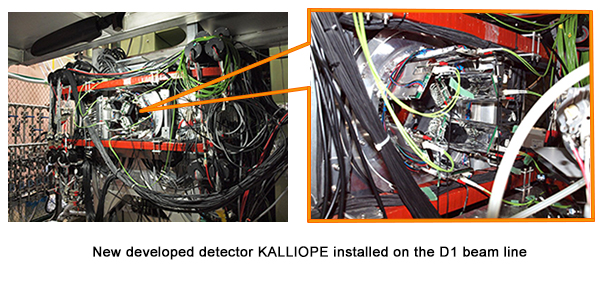 |
 * Click here to enlarge. * Click here to enlarge. |
| £to Page Top |
|
| Facility updates |
| Recovery work outside of building is progressing at the Linac, including backfilling of sunken areas around building, repair of the perimeter road, and repair of street gutters. Since last November the variable bending magnet system installed on the 3-GeV Synchrotron (RCS) to increase beam intensity going forward has been in operation, and at present beams are being smoothly supplied in the optimal beam form for each facility. At the 50-GeV Synchrotron (MR), development is underway on the main electromagnet power supply and a high-gradient acceleration cavity in order to shorten the repetition cycle of beam acceleration/extraction, and achieve the 750-kW beam output given in design specifications. At the MLF, in addition to the aforementioned experimental equipment for the D1 beam line installed in the muon experimental area, work to improve the experimental environment and the user safety was also completed. The work includes the installation of window glass in building evacuation doors and the construction of an evacuation stairway in the case of a tsunami. At the Hadron Experimental Facility, work was completed on a floor for laying rails to move heavy instruments, in preparation for construction of the K1.1 beam line on the south side of the experimental hall. At the Neutrino Experimental Facility, a special-purpose hoist was carried in for the 2nd and 3rd electromagnetic horns, which are scheduled to be replaced this summer. |
 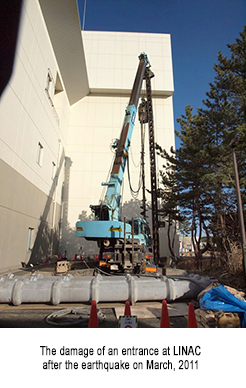 |
 * Click here to enlarge. * Click here to enlarge. |
 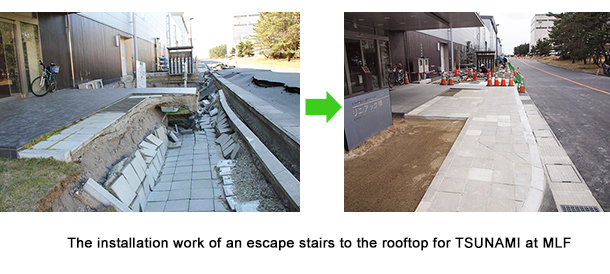 |
 * Click here to enlarge. * Click here to enlarge. |
| £to Page Top |
|
| The 12th Korea-Japan Meeting on Neutron Science |
| On February 3-6, the 12th Korea-Japan Meeting on Neutron Science was held at University of the Ryukyus (in Okinawa), and was attended by 36 participants from Japan and 23 participants from South Korea. This meeting was first held in 2000, and has been held every year since while alternating between the hosting countries. There are neutron facilities operating stably in both countries - the pulsed neutron source at J-PARC, and the HANARO research reactor (30 MW) in South Korea - and these have become the key bases in Asia for research using neutrons. Therefore, going forward these meetings will be held under the sponsorship of J-PARC and HANARO. At the recent meeting, there was a lively exchange of information, in five sessions and a poster session, on topics such as the current situation of facilities using neutrons in both countries, and the results of research. |
 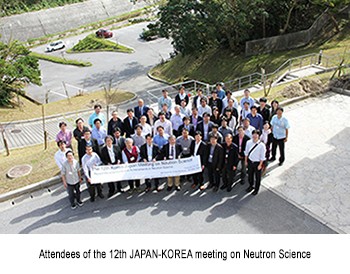  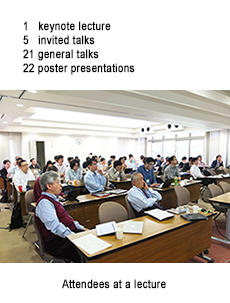 |
 * Click here to enlarge. * Click here to enlarge. * Click here to enlarge. * Click here to enlarge. |
| £to Page Top |
|
| International School for Strangeness Nuclear Physics 2013 |
| On February 14-20, the Second International School for Strangeness Nuclear Physics (SNP School 2013) was held at the J-PARC site and Tohoku University, with the participation of 40 students and young researchers from Japan and 30 from foreign countries. The first half (Feb. 14-16) was held at the J-PARC site. First, lectures were held at the Ibaraki Quantum Beam Research Center (IQBRC), and then the participants toured J-PARC on the afternoon of the 15th. They visited the Materials and Life Science Experimental Facility, Central Control Room, Neutrino Experimental Facility and Hadron Experimental Facility. Researchers active at each facility provided detailed explanations, and the participants had many questions. As an assignment, all participants were asked to prepare posters on their own research topics beforehand. On the afternoon of the 16th, there were presentations and a poster session by young researchers, and a lively discussion on the benefits of attending the school. The Hashimoto Prize was awarded for the best poster and presentation. On the 17th, everyone moved to Tohoku University, where the second half of the school (Feb. 18-20) was held. Note) The Hashimoto Prize was established for this school in recognition of the achievements of the late Professor Osamu Hashimoto who, while working at the Graduate School of Science of Tohoku University, fostered the development of strangeness nuclear physics in Japan. |
 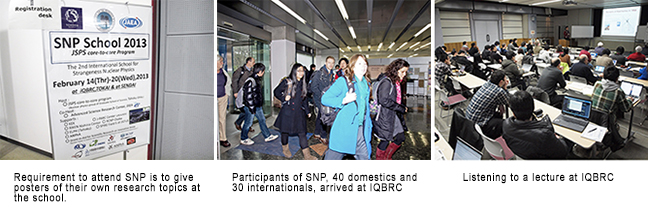 |
 * Click here to enlarge. * Click here to enlarge. |
| £to Page Top |
|
| Neutron Advisory Committee (NAC-2013) |
| On February 14-15, the Neutron Advisory Committee was held at the Ibaraki Quantum Beam Research Center (IQBRC). Speakers from J-PARC reported on matters such as the current situation at the MLF, and the response to proposals made by committee members last year. There were also explanations by researchers engaged in each phase of increasing beam intensity to the MW class, and improving the facility with the aim of becoming an international science center. In the summary, the committee highly praised the MLF's current situation and efforts toward the future, and suggestions were also made about the MLF's approach. |
 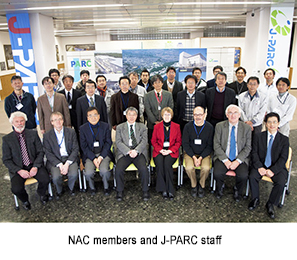  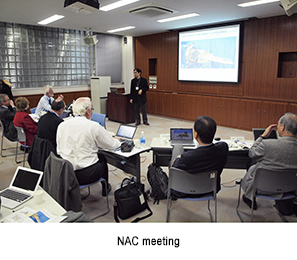 |
 * Click here to enlarge. * Click here to enlarge. * Click here to enlarge. * Click here to enlarge. |
| £to Page Top |
|
| 12th Accelerator Technical Advisory Committee (A-TAC) |
| This meeting was held on February 21-23 at the Ibaraki Quantum Beam Research Center (IQBRC) and was attended by 9 members of A-TAC, including 8 members from overseas. A-TAC received reports on the current status of accelerators, experimental facilities and the correspondence to recommendations that A-TAC provided on the future direction of accelerator development of J-PARC at the last meeting. |
  |
 * Click here to enlarge. * Click here to enlarge. |
| £to Page Top |
|
| Muon Science Advisory Committee (MuSAC)/Muon Advisory Committee (MAC) 2013 |
| This joint meeting MuSAC / MAC 2013 was held at the KEK Tokai Campus on February 22nd and 23rd, 2013. The MuSAC/MAC received the respective reports and lively discussed (1) research activities, (2) an inter-university research program and (3) the operation management of MUon Science Establishment (MUSE) at MLF. Six new proposals were also reviewed. The committee submitted recommendations on the consultations and the future of Muon Science at the end. ¡ Please refer to this J-PARC News No.95 (English) for the detail of "KALLIOPE". |
| £to Page Top |
|
| 2013 J-PARC International Advisory Committee (IAC) |
| Following the NAC, A-TAC and MuSAC/MAC, the 2013 meeting of J-PARC International Advisory Committee was held on February 25th and 26th at IQBRC and was attended by 11 members, including 8 from abroad. The IAC received updated reports on the near completion of restoration work from the earthquake and the current status of the experimental facilities and user operations. The IAC highly appreciated the efforts to issues and made recommendations on the future direction of J-PARC. |
  |
 * Click here to enlarge. * Click here to enlarge. |
| £to Page Top |
|
| Familiarization visit to JAEA and J-PARC |
| Dr. John Womersley, CEO of Science and Technology Facilities Council (STFC) and Dr. Peter Fletcher, Head of the International Office of STFC, visited J-PARC and Japan Atomic Energy Agency (JAEA) on February 24th and 25th. They also visited other large research facilities, SPring-8, K computer and RIKEN during their visit in Japan. At IQBRC, they discussed the J-PARC status and science firstly with Dr. Yokomizo Executive Director of JAEA (in charge of the J-PARC project) and then with Dr. Ikeda, Director of the J-PARC Center. After that they made a courtesy call on Dr. Nanba, Executive Director of JAEA (in charge of the JAEA international affairs). They exchanged ideas to further promote international cooperation for facilities between J-PARC, JAEA and the United Kingdom and the support system for researchers. |
| £to Page Top |
|
Copyright 2011 JAEA and KEK Joint Project. All rights reserved.
|
|